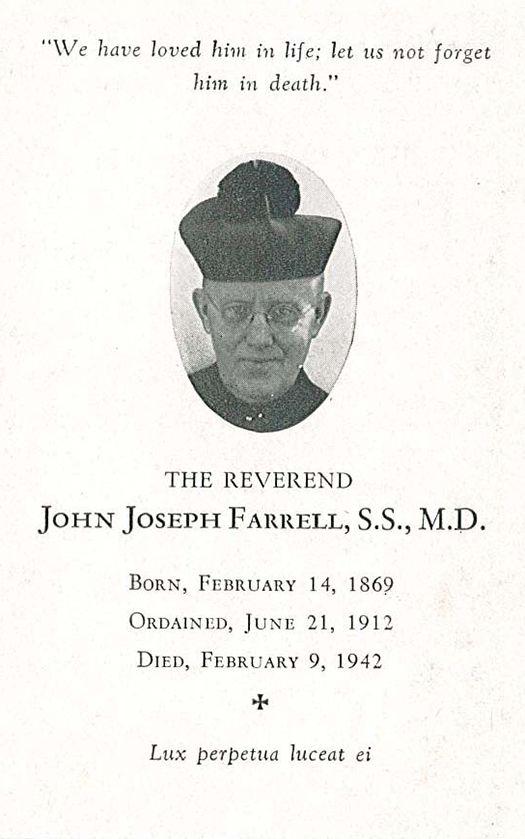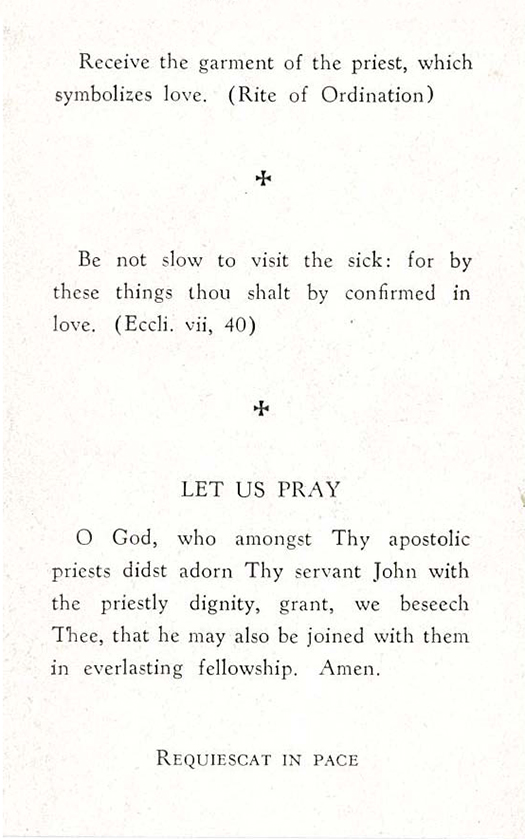Farrell, Father John
1942, February 9
Date of Birth: 1869, February 14
Issy
December 7, 1943
Fathers and Dear Confreres:
In order to make up for the involuntary delay that I have taken in sending on to you the customary notices on the confreres whom God has called to Himself, I want to recall in this circular letter the religious and moral traits of Fathers Périsse, Gigot, Portier, Dinneen, and Farrell, who belonged to the three provinces of France, Canada, and the United States. You will not be surprised at the brevity of these notices; present conditions have not permitted us to obtain on each of our deceased – except the first – information which is ordinarily sent to us on the life and death of Sulpicians whom the good God has admitted to eternal life. I must then rely on my own memories of them.
† † †
Father Farrell – John James Farrell was born on February 14, 1869 at Clarksburg in the Diocese of Wheeling in the State of [West] Virginia. He was ordained Priest in 1906.
Before entering the seminary, Father Farrell studied Medicine and perhaps exercised that profession for some years. After his ordination as a priest, he must doubtless have fulfilled some priestly costs in the Diocese of Wheeling or in some other diocese in the United States. What is certain is that he entered the Solitude in 1911.
The Solitude was the first held in the United States. It was an experiment which, in other respects holding to tradition, the American Sulpician province wished to make. It was opened in Washington in the former St. Austin’s College (similar to the Maison St. Jean) which we used to have in Paris. The Superior was the revered Father Havey, former Superior of the minor seminary in Boston, today retired at St. Mary’s Seminary in Roland Park. He had in an earlier day attended the Seminary of St. Sulpice in Paris.
When the opening of the American Solitude was decided on, Father Dyer, Provincial of the United States, sent him to Issy, where the future Superior had himself made his Solitude in 1897. There, during the 1911 vacation, Father Havey prepared himself with admirable zeal for his future job, taking many notes, interrogating various people, with fervor living again for two months the essentials of his own Sulpician formation. It was under such a master and model that Father Farrell was trained for the ministry of our houses. The community was small, it had only five aspirants. Of the five, four were admitted to the Society. One, still living, occupies a high position in the United States. Two have been dead for some years after exercising a very laudable ministry in two of our houses in the American province. They are Fathers Bast and Boone.
Father Farrell himself carried on a special mission for which his being a doctor fitted him. He was appointed to the minor seminary of St. Charles in Catonsville, near Baltimore, and given charge of the infirmary. He functioned more as a priest and a Sulpician than as a doctor. You ought to have seen him in his little world – consoling this one, scolding that one, giving medicine to another, watching the games of those not very ill! Briefly, he was the soul of the infirmary where he assumed as his own apostolate that of helping the St. Charles students to make “good use of their illnesses.”
Father Farrell’s role, it can be seen, was very self-effacing. He accepted it with simplicity. He fulfilled it with the spirit of faith, of zeal and conscientiousness, of friendliness and joy. We do not know when or in what circumstances the good God called Father Farrell to Himself. But we are sure that the good Sulpician was awaiting his Master, and that his soul heard the invitation of Jesus: “It is good, O Faithful Servant; enter into the joy of your Lord.”
I recommend to your prayers the souls of all these confreres and the Sulpician houses in which they lived and worked.
Please accept, Fathers and dear confreres, the expression of my respectful and fraternal affection in Our Lord.
P. Bosard
Vice-Superior General of St. Sulpice


